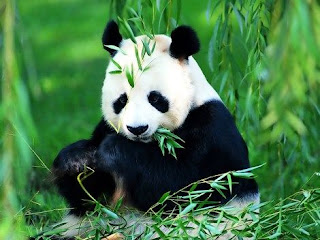Hey everybody! Wake up! Our giant panda is reducing. I want to save the giant pandas, would you guys help me? But before that I'll tell you about the giant panda. The science name for the giant panda is
Ailuropoda melanoleuca the meaning is "black and white cat-foot." the giant pandas belong to the carnivores, although it was carnivore, the giant panda's diet is 99% bamboo! Wow! Can you imagine that? Nowadays, the bamboo's were cut down to other man's property. Giant pandas can starve because there is no bamboo, if there is no bamboo and the giant pandas starve, they'll die! Giant pandas lives in a few mountain ranges in central China, mainly in Sichuan province, but also in Shaanxi and gansu provinces. Because of farming, deforestation and other development, the giant panda has been wiped out of the lowland areas where it once lived. While the dragon has historically served as China's national emblem, in recent decades the panda has also served as an emblem for the country. Its image appears on a large number of modern Chinese coins in gold, silver, bimetallic gold & silver, platinum, palladium, bronze, brass, and copper. The giant panda has a black and white fur. The adult's body measure is around 1.2m to 1.8m long if it's including the tail it's about plus 13cm. Giant panda's males weight is up to 160kg. Giant panda's female is 10-20% smaller than males, it can weigh as little as 75kg but can also weigh up to 125kg. A giant panda newborn cub typically weighs 90 to 130 grams. Giant pandas reach sexual maturity between the ages of four and eight, and may be reproductive until age 20.The mating season is between March and May, when a female goes into her estrous cycle which lasts for two or three days and only occurs once a year. There is no conclusive explanation of the origin of the word "panda". The closest candidate is the Nepali word
ponya, possibly referring to the adapted wrist bone.
Since the earliest collection of Chinese writings, the Chinese language has given the bear 20 different names, such as 花熊 (huā xióng) "spotted bear" and 竹熊 (zhú xióng) "bamboo bear"
. The most popular names in China today are 大熊貓 (dà xióng māo), literally "large bear cat", or just 熊貓 (xióng māo), "bear cat". The name may have been inspired by the giant panda's eyes, which have pupils that are cat-like vertical slits – unlike other bear species, which have round pupils.
In Taiwan, the popular name for panda is the inverted 貓熊 (māo xióng) "cat bear," even though many encyclopedia and dictionaries in Taiwan still use "bear cat" as the correct name. Some linguists argue that, in this construction, "bear" instead of "cat" is the base noun, making this name more grammatically and logically correct, which may have led to the popular choice despite official writings.
Here are some pictures of giant pandas:
Newborn giant panda
A giant panda eating bamboo1
A giant panda eating bamboo2
A mother giant panda and it's cub
Panda loves you





Tidak ada komentar:
Posting Komentar